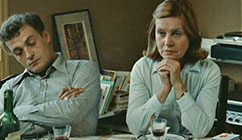|
|
|
|
La Gueule ouverte
|
 |
|
Maurice Pialat spent his lifetime (1925-2003) making films that are intense, emotionally raw, unpredictable, wayward – a kind of French cousin to John Cassavetes. La Gueule ouverte is the only film by Pialat whose plot is simple and easily tellable. A woman (Monique, played by Monique Mélinand) goes in for a routine medical check-up, but the problem that is discovered leads to her rapid deterioration. Meanwhile, every family member around her goes to pieces, handling it badly. The film’s title narrows the idea down even further: Monique goes from a walking, talking person to a near-comatose or catatonic ‘mouth agape’ – a slack-jawed mug – able to open only for the purposes of receiving food. This is the film in a nutshell: devastation of the human form, the human character, the human being – as concentrated in its most typically, iconically human feature: the face. Like every Pialat film, La Gueule ouverte is a closely observed, very uncomfortable tale of human devastation. Pialat’s films concern themselves, almost single-mindedly, with the fact, the process, the event of devastation, slow, gradual and irremediable: devastation of a relationship, a marriage, a family, a community, a way of life. Pialat presents all of this in the name of a grim realism all his own, a profound sense that this is just the way it is. Every anchor, every support system goes, one by one. Characters are, by the end, left alone, bereft, inconsolable, untouchable. But what passionate, angry, violent, grumpy resistance in Pialat to this Fact of Life! Each character in La Gueule ouverte, in his or her own way, refuses to ‘go with the flow’ of irrevocable devastation. They withdraw, or complain, or drink, or seek sexual solace in the arms of others. However, there is no escape from devastation in Pialat’s cinema. The way he constructs his films conveys a harsh drama of time, a type of time which is decidedly singular and brutally linear: many ellipses, but no flashbacks. Straight ahead, like a broken arrow, to its target. And the target is always something like solitude or death or a void. Along the way, we observe Pialat’s remarkable, unique skill with directing actors, with composing frames (here lit and shot by the great Néstor Almendros [1930-1992]), with capturing everything that is awkward and difficult in everyday interactions around a dining table, at a bar, or in bed. Pialat eschews all easy conventions, and every dramatic cliché: he aims for an authenticity that looks nothing, finally, like cinéma-vérité, but instead carves out a new and personal cinematic form. The way Pialat presents a house, a hand, a moment of violence or tenderness, is indelibly his, and his alone. Adapted from a longer piece on Pialat, “Devastation”, slated for a future collection of my essays on World Cinema Directors. For more on La Gueule ouverte, see my illustrated “Use No Hooks: Maurice Pialat/Manny Farber” in Movie, no. 6 (2015). © Adrian Martin March 2009 |
![]()